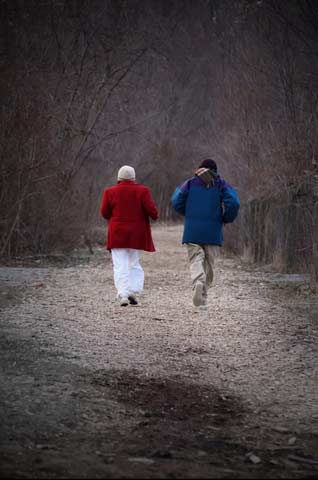Memory Boost for Aging Adults: Take a Walk

Forget the brain puzzles, mild exercise such as walking can boost brain volume and improve memory in older adults, researchers have found.
"With a limited investment of time and effort you can produce fairly dramatic improvements in memory and brain health," senior researcher Arthur Kramer, of the University of Illinois at Urbana-Champaign, told LiveScience. "You can roll back the clock about two years."
The hippocampus is the part of the brain involved in so-called declarative memory – the long-term memory of places, people, events and things. Kramer notes the main character from the movie "Memento," Leonard Shelby, who is unable to create new memories and as such would be lacking the use of his hippocampus.
This area of the brain shows the most drastic decline in old age, dropping about 1 percent to 2 percent in volume every year. As this happens, the brain cells shrink and pull back their links to each other while making fewer neurotransmitters, the proteins they use to communicate, Kramer said.
"The brain is a complex place," Kramer said. "A multitude of changes that happen as a faculty of aging reduces aspects of memory and cognition."
Seniors stepping out
The study followed 120 sedentary, but healthy, seniors between the ages of 50 and 80. They were randomly placed into two groups. The first was the exercise group, who walked for 40 minutes three times a week, while the control group did stretching and toning exercises. "We wanted to get them off of the couch and away from the TV and get their heart rate moving," study researcher Kirk Erickson told LiveScience.
Get the world’s most fascinating discoveries delivered straight to your inbox.
"We looked at the hippocampus because we know it's involved in memory formation," said Erickson, from the University of Pittsburgh. "It's one of the first regions to start showing decay in Alzheimer's disease, and we know from animal studies that it's modifiable."
The researchers scanned the participants' brains before, at six months and after a year and compared the sizes of parts of the brain over the time period. They saw that the exercise group's hippocampus actually increased in size on average, in comparison to the decrease in size in the stretching and toning group (similar to the average decline in the elderly population). "We know that the size of this region is really important, and generally bigger is better," Erickson said.
They also tested the participants for a protein called BDNF, high levels of which are associated with increased hippocampus size and memory, and tested their spatial memory, the memory of spaces and orientation, including the ability to navigate.
They found that as the hippocampus grew, spatial memory improved and BDNF also increased. The link to spatial memory improvements are slight, which Erickson notes might be because it's difficult to test for memory improvement in one specific brain region, and since the patients weren't actually experiencing memory problems before the intervention. Also, changes in the hippocampus won't improve all types of memory; those that reside outside the hippocampus could still decline.
Easy Exercise
The best part of the intervention, Kramer said, is that walking is free and easily accessible for everyone. "Walking is simple and straightforward, and you don't need to belong to a health club, though other forms of aerobic activities have similar effects," he said. Participating in exercise groups like SilverSneakers or 10,000 steps (recent guidelines suggest we should all take 10,000 steps a day) could help motivate seniors to walk more.
It seems likely that more and harder exercise will garner more health and brain improvements, since those who improved their fitness scores the most also increased their hippocampal size the most. "Those who exert more energy and do more activities tend to do better, tend to show a bigger improvement," Erickson said.
With the screens the researchers used, they weren't able to pinpoint the exact changes that occurred in the participants' brains. It could have been an increase in brain cell numbers, or stronger connections between those cells already there. It is also likely that new blood vessels, which bring oxygen and nutrients to the brain, could have infiltrated the area.
"You don't know what the increase is due to, in one trivial sense it could be just water," Carl Cotman, director of the Institute for Brain Aging and Dementia at the University of California at Irvine, who wasn't involved in the study, told LiveScience. "But if you translate the animal work it's likely due to changes in neuronal structure and increased blood flow."
Increasing aerobic exercise could help other sedentary people, as well. Kramer notes that he has seen similar cognition improvements with aerobic exercise in sedentary children, though in active people the effect probably plateaus at high levels of exercise.
The study is published in the Feb. 1 issue of the journal Nature Communications.
You can follow LiveScience Staff Writer Jennifer Welsh on Twitter @microbelover.
Jennifer Welsh is a Connecticut-based science writer and editor and a regular contributor to Live Science. She also has several years of bench work in cancer research and anti-viral drug discovery under her belt. She has previously written for Science News, VerywellHealth, The Scientist, Discover Magazine, WIRED Science, and Business Insider.



